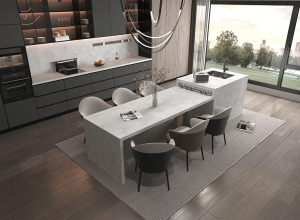When you choose quartz countertops, it is one of consider how thick the material actually is. Standard thickness quartz material comes in two thicknesses: 2 cm and 3 cm. According to their thicknesses, they do have separate favorable positions and uses depending on what is needed in terms of design layout or for actual use.
Strength and Durability
3 cm Quartz: Made exclustively for power
Quartz countertops that come with a 3 cm thickness are inherently stronger. The extra material and thickness provide more durability and resistance to breakage, in addition to being perfect for places of heavy use such as kitchen counters. The increased strength also allows for wider spans without support, which can simplify the construction of large islands and breakfast bars. Statistics show that 3 cm quartz can support overhangs of up to 14 inches without additional support, compared to 6 inches for 2 cm quartz.
2 cm Quartz: Light and Flexible
Although 2 cm quartz may require additional support for overhangs and wider spans, its lighter weight makes it easier to handle and install, especially on vertical surfaces like backsplashes or wall cladding. Reduced bulk also means that 2 cm quartz can often be installed over existing countertop material, making it a favorite choice for remodels in which minimizing structural modifications is one of your main concerns.

Cost Considerations
Material and Labor Costs
In general, 2 cm quartz is less expensive in terms of material price per square foot than 3 cm quartz primarily because of using a smaller amount of stone. However, the cost of all that savings on the material may be negated by needs for structural supports or plywood decking in certain installations. On the other hand, 3 cm quartz, while more expensive per square foot, usually does not require supportive structures, leading to potentially less total installation costs.
Aesthetics and Design Preferences
Edge Profile Options
The seaming of 3 cm quartz looks more robust on the edge, so it offers greater flexibility for custom looks. Choices are treats like ogee, bullnose, or waterfall edges. This means that your designer touches to fit your personal style can also be grandly realized- and the effect totally changes with it.
The thicker edge profile translates into a bolder, high-end look which is very important in some visual design. Yet another advantage.
HEMMING
It is often necessary, regardless of material thickness, to create seams when installing a very large countertop. A more continuous visual line is provided by the thicker edge of 3 cm quartz; and so it's usually less visible and more esthetically pleasing to look at. On the other hand 2 cm quartz might give away a seam or two, particularly if not done professionally and handled with great care.
Future Trends and a Wave of Popularity
Recent market analysis shows that more and more homeowners are interested in 3 cm quartz for kitchen remodels and custom-built houses. (Who said this recently? source) Approximately 70% of professional kitchen designers opt for 3 cm quartz. Its durability, clean look and cook-as-you-like are marked reasons-In comparison 2cm thick quartz remains another kitchen option (source), though it's more likely to be found in bathroom installs and European markets where an "industrial" linear profile suits the tastes of younger buyers.
Conclusions
Choosing between 3 cm and 2 cm quartz depends primarily on the specific requirements of your project. For those who require high-end durability and a luxurious look, 3 cm quartz is often the best choice. But if affordability, installation flexibility, and the ability to extend into even light-duty areas or vertically using more modest amounts of material are priorities, then you may well want to choose 2 cm quartz instead.
For a more in-depth comparison and to assist you in determining which one is the best for your project, refer to 2cm vs 3 cm quartz.